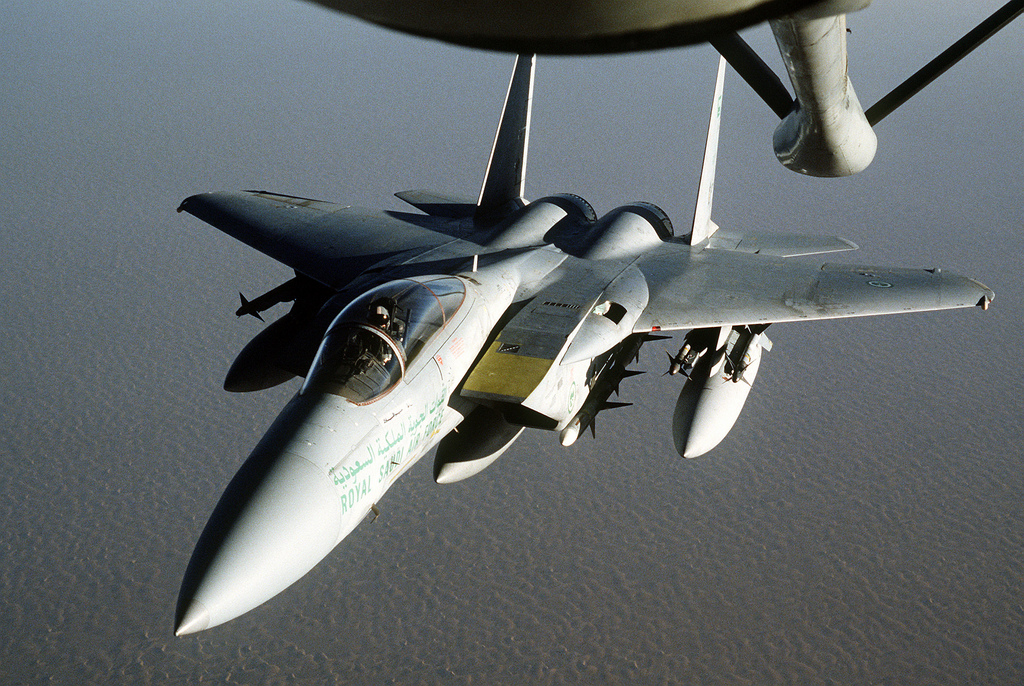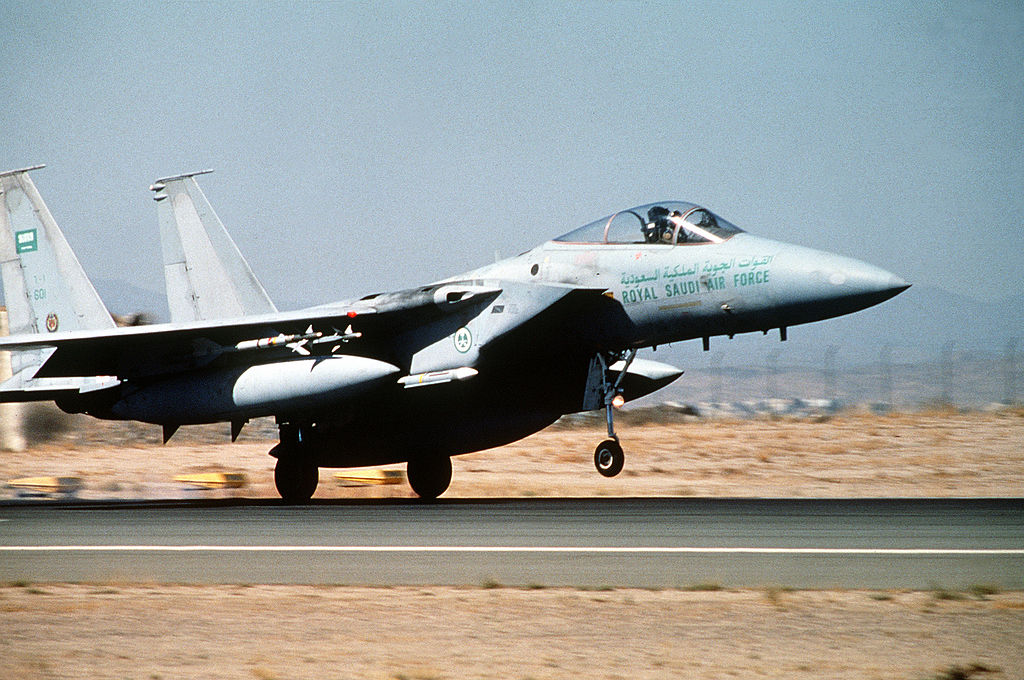Following the interception of radio traffic between the F-15s and the AWACS, Iran later claimed — logically — that the pilots aboard the two Eagles were not Saudis, but Americans
In the Foreign Military Sales (FMS) program Peace Sun, the Royal Saudi Air Force (RSAF) ordered 16 F-15Ds and 46 F-15Cs (without some of the aircraft’s Tactical Electronic Warfare System components and sensitive radar modes). The purchase came after the Saudi monarchy made a concentrated effort to overcome a capability gap between the RSAF and the F-14 Tomcat aircraft of the Islamic Republic of Iran Air Force (IRIAF).
The U.S. government had to take into account some very important political issues as a result of Peace Sun, not the least of which was how the sale was certain to be received by the ever-watchful Israelis. The RSAF Eagles were downgraded to make them less effective, especially against avionics and weaponry produced in the United States, in order to reduce such tensions.
Amid heightened tensions with Iran, the RSAF executed its first F-15 kill most extraordinarily. There is still debate about the incident today. A P-3F Orion from the IRIAF intercepted a merchant ship south of Lavan Island on the Saudi side of the Persian Gulf on June 5, 1984.

In the ongoing conflict between Iran and Iraq, the Iranians had been waging an attrition war against Iraqi oil tankers, and now the IRIAF had been instructed to target vessels passing through Saudi Arabian and Kuwaiti ports as well since both nations were secretly supporting Iraq in its war against Iran.
Two IRIAF F-4E Phantom IIs from TFB 6 (61st TFW) were dispatched to attack the vessels, as detailed by Steve Davies in his book F-15C Eagle Units In Combat, but they were quickly spotted by an American Air Force (USAF) E-3 AWACS flying out of Saudi Arabia. Two RSAF Eagles from No 6 Sqn—an F-15C and an F-15D—were already in the air and engaged in a training flight with a USAF KC-10A Extender tanker. The AWACS controller directed the Eagles away from the tanker track and toward the threatening F-4s because he knew the merchant shipping was in immediate danger.
It took a lot of effort to get the RSAF Eagle pilots to intercept F-4Es. It’s thought that the controllers on the AWACS had to plead with the Eagle pilots to comply with their instructions. The Saudis didn’t agree to the job until USAF instructor Capt Bill Tippin sat in the back of the F-15D and urged them to go for the intercept. The two Eagles attacked the F-4Es head-on as they approached the Saudi island of Al-Arabia, which is located 48 miles north of the al-Jubayl naval base.
The Eagle pilots finally attained radar locks that allowed each to fire an AIM-7 Sparrow under Tippin’s direction and with the aid of a Saudi officer on board the AWACS. One F-4E was brought down in a massive explosion by both guided missiles while the other was seriously damaged. The latter aircraft limped away severely damaged, but its pilot was able to make an emergency landing on what is now Kish Island, an Iranian holiday resort. 1Lts Hamayoun Hekmati and Seyed-Cyrus Karimi, who were on board the lost F-4, died in the explosion because they failed to attempt to eject.
Iran later asserted that the pilots of the two Eagles were not Saudis but rather Americans after radio communications between the F-15s and the AWACS were intercepted. Capt. Bill Tippin may have played a bigger part in the combat than has been acknowledged, but neither the Saudi or American governments have ever provided a complete explanation for the episode.
Although there is no means to actually release ordnance from the back seat of the D-model, there is little doubt that it could only have been the front seat pilot who actually fired the AIM-7 that scored the kill. It is possible that Tippin was actually flying the F-15D during the engagement.
General Spencer M. “SAM” Armstrong, a highly decorated USAF command pilot with more than 4,500 flight hours, who commanded the U.S. Military Training Mission to the Royal Saudi Air Force from July 1983 to July 1985, has provided important additional information about the engagement. Around this time, Saudi F-15 Eagles and Iranian F-4E Phantoms engaged in aerial combat.
The general spoke quickly when he was questioned about the participation of USAF pilots. “In short, there were no USAF pilots involved except in reviewing the film for the RSAF.” In addition, Gen. Armstrong claimed to be familiar with the names of the USAF F-15 pilots under his command but was unable to recall Capt. Bill Tippin.
A verbatim account of what happened on June 5, 1984, as given by Gen. Armstrong to Donald J. McCarthy Jr. for publication in The Raptors All F-15 and F-16 aerial combat victories is given below.
“The war between Iran and Iraq was really hot during my two years. Shortly after I got there, the Iranians sunk an Iraqi oil tanker in the Gulf and the Iraqis struck back with their French-made Exocet air-to-surface missiles—the “tanker war” was well underway. The Iranians did not have us to maintain their aircraft anymore so their equipment was in poor shape. The Iraqis soon had the advantage in this war on the Gulf. The Saudis were concerned the Iranians might go after the oil facilities or the desalination plant on the Gulf since the Saudis were assisting the Iraqis. They wanted to maintain an F-15 Combat Air Patrol [CAP], but needed in-flight refueling. We obliged by sending two KC-10 tankers over and the 24-hour CAP was begun.
“Beth [Mrs. Armstrong] and I were having lunch at the Mission Inn in Dhahran when the chief of the Dhahran advisory detachment came hurrying over. He took me aside and said they had reason to believe there had been a shoot-down over the Gulf. Together we hurried dawn to the tactical operation center [TOC], where US personnel manned surveillance radar. He told me on the way it appeared two F-15s had shot down one or two Iranian F-4s. I found Col. [Prince] Turki standing by a radar display, talking to some RSAF F-5s. Iranian helicopters were on the Saudi side of the Gulf, apparently looking for survivors. The Saudis got a lot of their intelligence from people on the oil platforms out in the gulf, and one of them reported the helicopter appeared to have missiles. I was pretty sure they were mistaking the skid on the helicopter for missiles because these were helicopters we had sold to them years earlier. Turki looked at me and asked if I thought we should order the F-5s to shoot down the helicopter. Trigger authority had been delegated to Turki, although he had never had to use it. I shook my head and Turki ordered the F-5s to merely shoo the helicopter away.

“When our F-15 pilots had a chance to review the tapes some interesting facts came out. Two Iranian F-14s were headed directly for Dhahran from Busheir while two F-4s had come around the north end of the Gulf and were heading down the Saudi side at a low level. The Saudi controller aboard a U.S. AWACS ordered Blue Flight to intercept the F-4s and ordered Yellow Flight—just taking off from Dhahran—to intercept the F-4s. The RSAF major leading Yellow Flight quickly sized up the geometry and ordered Blue Flight to take on the F-4s. The F-14s were merely a feint, as they turned around and went home in the middle of the Gulf.
“The two RSAF lieutenants turned hard left and descended for a head-on pass. The closure speed was about 1,200 mph. The F-15 wingman fired at maximum range for a radar missile and the leader must have had a case of “buck fever,” since he forgot to jettison his drop tanks and fired a missile at a minimum range of effectiveness. They observed two explosions, but they could not tell if the missiles hit the F-4s or merely impacted the Gulf. Since radar contact was lost for both F-4s it was reckoned both F-15s achieved kills. The water was shallow where the plane[s] went down, but very murky conditions prevented the discovery of the wreckage. They did find a seat cushion from an F-4. Each RSAF pilot was presented with a Mercedes 500 SEL as a token of appreciation from the king. Later at Taif, Prince Sultan asked me if they shot down one or two aircraft. I replied that it was one for sure and probably both. He replied they were claiming only one since they did not want to necessarily upset the Iranians any more than they had to.”
The Raptors All F-15 and F-16 aerial combat victories are published by Schiffer Publishing and are available to order here.
F-15C Eagle Units in Combat is published by Osprey Publishing and is available to order here.
Photo by Saudi88hawk and Shahram Sharifi via Wikipedia, U.S. Air Force


